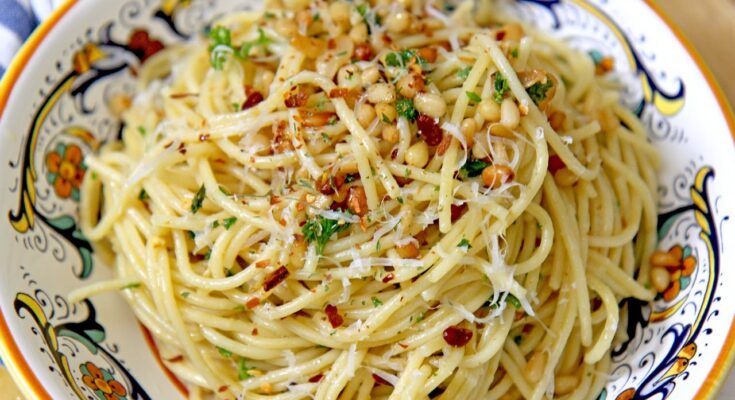Aglio Olio Recipe: Spaghetti Aglio e Olio is one of those rare dishes that proves less really can be more. It hails from Naples, Italy, and is the very definition of simplicity. At its heart, it’s just pasta, garlic, and olive oil. That’s it. But don’t let the basic ingredient list fool you—when cooked right, this dish packs a punch of flavor that rivals the most complex sauces.
What makes Aglio Olio stand out? It’s that golden balance of sautéed garlic mellowed out by good-quality olive oil, tangled up with al dente spaghetti, and just a hint of red pepper flakes for a subtle kick. It’s fast, it’s inexpensive, and it’s absolutely delicious. No fancy ingredients or time-consuming steps—just pure, rustic Italian soul on a plate.
Plus, it’s vegetarian, and when done right, it’s vegan too. This makes it a go-to meal when you’re low on groceries but craving something comforting and satisfying. It’s a pantry meal in the best sense—humble yet heavenly.
Why It’s a Favorite in Italian Cuisine
There are a few good reasons why Aglio Olio is a staple in many Italian households. First, it’s incredibly quick to make—often ready in just 15–20 minutes. That’s faster than ordering takeout and waiting for it to arrive. Secondly, the ingredients are pantry basics—most homes have olive oil, garlic, and pasta on hand at any given time.
But more than convenience, Italians love Aglio Olio because of its flavor profile. Garlic and olive oil are two cornerstones of Italian cooking. When you sauté garlic in olive oil just right, you release its nutty sweetness without the bitterness that comes from overcooking. Add pasta, and you’ve got a dish that tastes luxurious even without butter or cream.
This dish also reflects the core philosophy of Italian cooking: use a few high-quality ingredients and let them shine. It’s the ultimate comfort food and a timeless classic that even beginner cooks can master.
Ingredients Needed for Authentic Aglio Olio
Core Ingredients You Can’t Skip
To make a truly authentic Aglio Olio, stick with the basics—but make sure they’re the best you can get:
- Spaghetti – Classic choice, but linguine works too. Cooked to a perfect al dente texture.
- Garlic – The star of the show. Fresh cloves, finely sliced or minced.
- Olive Oil – Use extra virgin olive oil for that deep, rich flavor.
- Red Pepper Flakes – Just a pinch adds warmth and character.
- Salt – For the pasta water and final seasoning.
- Pasta Water – Reserved during cooking; this starchy water helps emulsify the sauce.
When these ingredients come together, they create a creamy, glossy coating on the pasta without using butter or cream. That’s the magic of pasta water mixed with oil and garlic.
Optional Add-Ons to Enhance Flavor
Once you’ve mastered the basic recipe, you might want to jazz it up with a few extras. Here are some popular additions:
- Parsley – Adds color and freshness. Chop it finely and sprinkle at the end.
- Parmesan Cheese – Not traditional, but some like the umami boost.
- Lemon Zest – Brightens the dish with a citrusy twist.
- Anchovies – Melt into the oil for a savory depth.
- Mushrooms or Cherry Tomatoes – For added texture and color.
Remember, the original charm of Aglio Olio lies in its simplicity. So while these add-ons are tasty, use them sparingly so they don’t overpower the garlic and olive oil.
Kitchen Tools You’ll Need
Essential Tools for Making Aglio Olio
You don’t need fancy equipment to whip up Aglio Olio, but having the right tools makes it easier and more enjoyable:
- Large Pot – For boiling the pasta with plenty of salted water.
- Large Skillet or Frying Pan – To sauté the garlic and mix in the pasta.
- Tongs or Pasta Fork – For tossing the pasta evenly in the sauce.
- Ladle or Cup – To reserve some pasta water before draining.
- Cutting Board & Knife – For slicing garlic and prepping any extras.
Having a non-stick or stainless-steel pan can help distribute heat evenly, which is crucial when you’re sautéing garlic—you want golden, not burnt.
Prep Tips for a Smooth Cooking Process
Aglio Olio moves fast once you start, so prep is everything. Here’s how to set yourself up for success:
- Slice the garlic first – Make sure it’s ready before you heat the oil.
- Boil water in advance – Salt it generously—it should taste like the sea.
- Measure your pasta – About 100g (3.5 oz) per person is standard.
- Reserve pasta water before draining – This step is crucial for the final sauce.
- Chop any optional ingredients – Like parsley or anchovies—get them ready before you start cooking.
When everything is prepped ahead, cooking becomes seamless. You’ll be tossing your pasta like a pro in no time.
Step-by-Step Cooking Instructions
Step 1: Boil the Pasta to Al Dente
First things first—get your pasta water boiling. Use a large pot with plenty of water so the spaghetti can cook evenly without sticking together. Don’t forget to salt the water generously. Think of it this way: this is your only chance to season the pasta itself, so go bold. A good rule of thumb is 1 tablespoon of salt per 4 quarts (liters) of water.
Once the water reaches a rolling boil, add your pasta. Stir immediately to prevent sticking. Set a timer according to the pasta package instructions, usually around 8-10 minutes. You’re aiming for al dente—which means the pasta should be firm to the bite, not mushy. Overcooked pasta ruins the texture of Aglio Olio.
Just before draining, reserve about 1 cup of pasta water. This starchy water will help emulsify the olive oil and garlic, creating that silky coating that makes the dish irresistible. Then drain your pasta and let it sit for a moment while you work on the sauce.
Step 2: Sauté Garlic to Perfection
Now it’s time for the heart of the dish—the garlic. In a large skillet over medium heat, pour in a generous amount of extra virgin olive oil. For 2 servings of pasta, about 1/4 cup of oil is perfect.
Once the oil is warm (but not smoking), add your thinly sliced garlic. Stir it gently and watch it closely. The garlic should sizzle softly and turn a light golden brown. Be extremely careful here—garlic burns quickly, and once it does, it turns bitter and ruins the whole batch.
If you’re using red pepper flakes, toss them in once the garlic starts to color. About 1/4 to 1/2 teaspoon is enough, depending on how spicy you like it. Give it a quick stir and let the flakes infuse into the oil for a few seconds.
This step takes around 3-4 minutes. The goal is a fragrant, slightly nutty aroma with golden, not brown, garlic slices. Once that’s done, it’s time to bring it all together.
Step 3: Combine Pasta with Garlic-Infused Oil
With your garlic perfectly sautéed and your pasta drained (don’t forget that reserved water!), add the spaghetti straight into the skillet with the oil. Use tongs to toss the pasta in the garlic oil, making sure every strand is coated.
Now comes the magic: gradually pour in a bit of the reserved pasta water—about 1/4 cup at a time—and toss. The starch in the water helps the oil cling to the noodles and creates a light, glossy sauce.
Keep tossing and mixing over medium heat until the pasta looks silky and evenly coated. If it looks dry, add a bit more pasta water. The final texture should be slick, not greasy or watery. At this point, taste for salt and adjust as needed.
You can also stir in some freshly chopped parsley or a grating of Parmesan if you’re going for a deluxe version. But remember—less is more.
Step 4: Final Touches and Garnishing
Once everything is perfectly tossed and seasoned, remove the skillet from heat. Now’s the time to add any finishing touches:
- Fresh parsley – adds a fresh pop of green and mild herbal flavor.
- A drizzle of extra virgin olive oil – enhances the aroma.
- Freshly cracked black pepper – for a subtle bite.
- Parmesan cheese – totally optional, but adds umami.
- Lemon zest – if you want a light citrusy note.
Plate the pasta immediately. Aglio Olio is best served hot and fresh, straight from the pan. The longer it sits, the more the pasta absorbs the oil, and you may lose that silky texture.
So grab your fork and dig in—it’s time to enjoy the fruits of your (simple) labor.
Pro Tips to Elevate Your Aglio Olio
How to Prevent Overcooking the Garlic
This is probably the #1 mistake people make with Aglio Olio. Burnt garlic is bitter and overpowering, and it can turn your lovely pasta into a culinary disaster. To avoid that:
- Start with medium or medium-low heat. High heat is too aggressive.
- Use sliced garlic instead of minced. It’s less likely to burn and gives a mellower flavor.
- Remove the skillet from heat if needed. If the garlic is browning too quickly, just lift it off the stove.
- Keep stirring. Garlic slices cook more evenly when moved around a bit in the oil.
If you mess up and the garlic burns—start over. There’s no fixing burnt garlic.
Choosing the Right Pasta Type
Traditionally, Aglio Olio is made with spaghetti, and for good reason. It holds the oil well and gives you that satisfying twirl on your fork. But if you want to experiment, here are a few other good options:
- Linguine – slightly flatter than spaghetti, but just as effective.
- Fettuccine – works well if you want a heartier bite.
- Capellini (angel hair) – very delicate, cooks fast, but can become mushy quickly.
- Gluten-free pasta – if dietary restrictions apply, just be cautious not to overcook it.
Always go for a high-quality pasta brand. It makes a difference in texture and taste. Bronze-cut pasta, in particular, has a rougher surface that holds onto the garlic oil beautifully.
Variations of Aglio Olio You’ll Love
Add Protein for a Heartier Meal
While the traditional Aglio Olio is a minimalist, meat-free dish, there’s nothing stopping you from adding some protein if you want to make it more filling. Here are some tried-and-true additions:
- Grilled Chicken – Slice it thin and add on top for a lean protein boost.
- Shrimp or Prawns – Sautéed with garlic, they blend in beautifully with the flavors.
- Bacon or Pancetta – Adds a smoky, salty element that pairs well with the olive oil.
- Tofu or Tempeh – For a vegan-friendly protein option, pan-fry tofu cubes and toss them in at the end.
These additions can make Aglio Olio a complete meal while still maintaining that garlicky punch.
Spicy Aglio Olio Twist
Love heat? Then boost the red pepper flakes to create a spicy version of Aglio Olio that wakes up your taste buds. You can also:
- Infuse the oil with whole dried chilies for more depth.
- Add a pinch of cayenne pepper for an extra kick.
- Toss in some chili oil at the end instead of plain olive oil.
Spicy Aglio Olio is perfect for those who crave bold flavors. Pair it with a crisp white wine to balance the heat.
Serving Suggestions
Perfect Pairings with Aglio Olio
Though Aglio Olio is a star on its own, it plays well with others when served as part of a complete meal. Consider these pairings:
- Side Salad – A fresh green salad with lemon vinaigrette balances the richness of the oil.
- Crusty Bread – Perfect for soaking up the leftover garlic oil on the plate.
- Roasted Vegetables – Zucchini, bell peppers, or asparagus make great companions.
- Soup Starter – A light broth or tomato-based soup can start the meal off nicely.
These sides keep the meal light, refreshing, and wholesome without overshadowing the simplicity of the pasta.
Best Drinks to Serve Alongside
The flavors in Aglio Olio are simple and elegant, so you’ll want drinks that complement rather than compete. Here are a few favorites:
- White Wine – A crisp Pinot Grigio or Sauvignon Blanc balances the garlic and oil.
- Sparkling Water – A refreshing cleanser between bites.
- Lemonade – If you’re going non-alcoholic, lemon pairs wonderfully with the garlicky undertone.
- Light Beer – A pilsner or blonde ale works well for those who prefer beer with dinner.
Whatever you choose, make sure it’s something light and refreshing to let the pasta shine.
Health Benefits of Aglio Olio
Nutritional Value of Key Ingredients
Don’t be fooled by how indulgent Aglio Olio tastes—it’s actually quite nutritious when made with quality ingredients and eaten in moderation.
- Garlic – Rich in antioxidants and contains compounds that help reduce inflammation and support heart health.
- Olive Oil – A source of healthy monounsaturated fats that can lower bad cholesterol.
- Pasta – Provides complex carbohydrates, especially if you choose whole grain or legume-based pasta.
- Red Pepper Flakes – Contain capsaicin, known to aid metabolism.
It’s a well-balanced meal if you’re watching your fat and carb intake while also aiming for big flavor.
Vegan, Vegetarian, and Gluten-Free Adaptations
The base recipe for Aglio Olio is naturally vegetarian and can be easily tweaked for various diets:
- Vegan – Simply skip the cheese or use a vegan Parmesan substitute.
- Gluten-Free – Use gluten-free pasta made from rice, quinoa, or chickpeas.
- Low-Carb – Substitute traditional pasta with spiralized zucchini (zoodles) or shirataki noodles.
This flexibility makes Aglio Olio an excellent choice for dinner parties or family meals where dietary needs vary.
FAQs About Aglio Olio Recipe
1. What is Aglio Olio?
Aglio Olio is a classic Italian pasta dish made with garlic (aglio), olive oil (olio), and spaghetti. It’s simple, flavorful, and ready in under 20 minutes.
2. Can I add protein to Aglio Olio?
Yes, you can enhance the dish with grilled chicken, shrimp, or even bacon for extra flavor and nutrition.
3. Is Aglio Olio spicy?
Traditionally, it includes red pepper flakes for a mild kick. Adjust the amount to suit your heat preference.
4. What type of pasta works best?
Spaghetti is the traditional choice, but linguine or angel hair pasta also work well.
5. Can I make it ahead of time?
Aglio Olio is best served fresh. However, leftovers can be stored in an airtight container and reheated with a splash of olive oil.
6. Is it suitable for vegans?
Absolutely! A basic Aglio Olio recipe is vegan-friendly—just avoid adding cheese or meat unless using plant-based alternatives.
7. How do I prevent the garlic from burning?
Cook garlic on low to medium heat. Burnt garlic tastes bitter and can ruin the dish’s flavor.
8. What can I serve with Aglio Olio?
Pair it with garlic bread, a side salad, or roasted vegetables for a complete meal.
Conclusion
Aglio Olio proves that simplicity doesn’t mean sacrifice. With just a handful of ingredients and a few thoughtful techniques, you can create a dish that’s both elegant and deeply satisfying. Whether you’re a student cooking in a dorm, a busy parent, or a food lover experimenting in the kitchen, this recipe is one you’ll return to again and again.
Don’t be afraid to make it your own. Add some protein, spice it up, or keep it classic. It’s all about what feels right for your taste buds and your lifestyle. So light the stove, slice some garlic, and dive into the comforting world of Italian simplicity—one delicious bite at a time.



